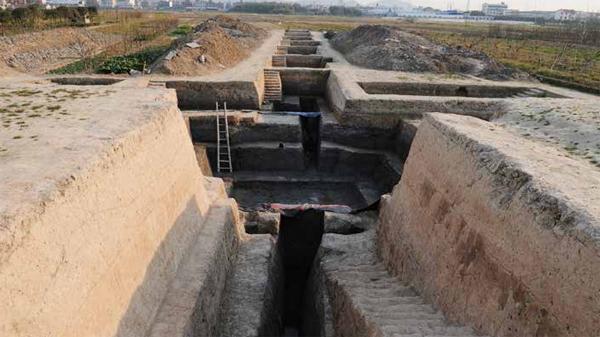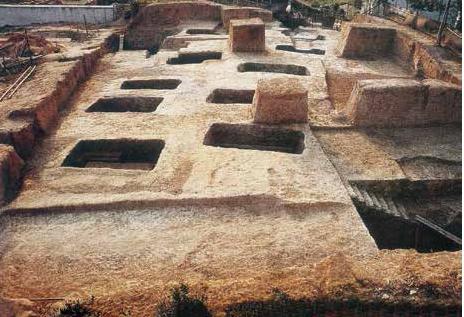漫漫申遗路,25年如何走过

鸟首纹。
良渚遗址的申遗之路,其实最早是从1994年开始的,每一步“动作”,也和良渚考古发现的进程紧密结合。
1994年,国家文物局将良渚遗址群推荐列入《世界遗产名录》预备清单。
这一年,莫角山宫殿区正式确认了。这当然是个重磅消息。
1987年及1992年、1993年,通过对莫角山遗址的发掘,学界认识到这个面积约30多万平方米、相对高度约10米的大型土台是良渚文化人工堆筑营建的大型宫殿基址。如此规模宏大的建筑遗址,以及此前发现的反山、瑶山、汇观山等出土的大量精美玉器,反映此地区应是良渚文化的中心所在。
从20世纪80年代末到90年代,良渚一带的考古工作几乎没有中断。1998年到2002年,浙江省文物考古研究所对良渚一带约50平方公里的范围进行了拉网式的详细调查,共確认遗址130多处。
1996年,国务院将良渚遗址公布为全国重点文物保护单位。
2001年9月,正式成立杭州良渚遗址管理区。
2000年,良渚申遗过程的关键人物,中国建筑设计院有限公司建筑历史研究所负责人、名誉所长陈同滨,第一次来到良渚,开始接手编制《良渚遗址保护和总体规划》。
她面对的最大的问题,是考古遗址的分布边界轮廓不清楚,“良渚这类考古遗址的分布边界肯定不是一次性就能完整发现的,但我们的保护规划要一次性做到完整保护。”所以对陈同滨来说,最大的挑战,就是良渚遗址的分布范围到底到哪里。
当时,浙江省文物局副局长陈文锦对她说:“良渚是重要的,我来组织,把三代考古学家聚到一起,我们一起来讨论这个问题。”
他们只能凭借规划技术,用GPS推进工作。分了两个组,请考古人员带着陈同滨的团队指认135个遗址点,同时她和一位副所长开始跑遗址的分布区边界的地形,最后通过分析技术,把图做了出来。
2002年,良渚遗址的保护区划边界划出来了;2003年通过国家级专家评审;2007年良渚古城被发现。古城不仅在保护范围内,而且在重点保护区内。
陈同滨依据自己的经验,采用了遗存密集分布区概念,遗存越密集,东西越丰富,再结合地形地貌,划出边界。“这是良渚规划里,我很欣慰的一点.我们在良渚遗址保护规划的技术中创立了一套大遗址保护的区划理论和技术,包括城镇化进程下的大遗址保护规划对策,从一开始就证明是对的。”
那年划边界的工作,让良渚遗址申遗和保护有了突破性的进展。

良渚古城外美人地遗址发掘现场。
2006年,国家文物局将良渚遗址列入《中国世界文化遗产预备名单》。
那一年,葡萄畈一次不起眼的发掘,让良渚古城渐渐露面在世人眼前。
葡萄畈,是莫角山遗址西面约200多米的一块低地,边上有个小池塘,东侧紧贴一垄南北向的高地。河道底部发现的石头,引起考古专家的高度重视。
2007年3月至4月中旬,考古队的钻探和试掘表明,底部的块石全面覆盖了莫角山遗址的西侧,南连凤山,北接东苕溪,总长度约1000多米,宽约40~60米。
显然,这是个庞大的工程。
2007年11月29日,良渚古城发现的消息正式对社会公布。这标志着良渚遗址进入都邑考古新阶段,当时被人们认为“石破天惊”。
2009年到2012年,通过大规模勘探和地理信息系统GIS分析以及解剖发掘,证实古城外部存在一个由扁担山、和尚地、卞家山等条形人工高地构成的外郭城,证实良渚古城由内而外具有宫城、内城、外郭的完整结构,是中国古代都城三重结构的滥觞。
2012年,国家文物局再次将良渚遗址列入《中国世界文化遗产预备名单》,随即实质性启动申遗工作。
2010年,良渚遗址被列入第一批国家考古遗址公园名单。中央财政不断加大投入,用于良渚遗址持续考古发掘,取得良渚古城和外围水利系统等一系列重大发现。在国家文物局和浙江省、杭州市人民政府的共同努力下,良渚遗址的申遗文本编制、价值研究提炼、法律法规修订、遗址保护展示和环境整治等专项工作均顺利开展。

良渚古城遗址申遗文本。
2012年,良渚古城遗址申遗文本启动——由陈同滨主持,与浙江省文物考古研究所、杭州良渚遗址管理区管理委员会共同编制良渚申遗文本。
我们现在看到,列入《世界遗产名录》的良渚古城遗址范围分成四大片区,其中包含了外围水利系统,这是在2017年新增的。
2009年至2016年,良渚古城外围水利系统的确认,使良渚古城遗址的价值内涵获得极大的提升;而逐步揭示的古城规模则远超同时期世界其他文明的都城遗址。
“申报良渚遗产,水利系统要不要算进来?开始有建议提出,选两三个点进去代表一下行不行?我说不行,要么不选,要选就得完整的,因为世界遗产讲究完整性。”陈同滨说。
2017年3月,国家文物局副局长宋新潮到现场看了以后,当即拍板:全上。
2017年3月底,良渚古城遗址的申报范围正式确定包括外围水利系统。
2018年1月26日,经国务院批准,中国致函联合国教科文组织世界遗产中心,正式推荐“良渚古城遗址”作为2019年中国世界文化遗产唯一申报项目。
随后,杭州良渚遗址管理区管委会举行了记者见面会。这也是良渚申遗的情况首次向公众公开。
同年1月29日,杭州良渚遗址管理区管委会赴巴黎向联合国教科文组织世界遗产中心递交申遗文本,良渚古城遗址申遗迈出关键一步。
2018年9月,ICOMOS(联合国教科文组织世界遗产中心委托的评估机构国际古迹遗址理事会)派遣印度考古学家莉玛·胡贾女士对良渚古城遗址进行了现场考察评估。
她在评估过程中对良渚遗址的价值和保护管理给予了充分肯定。
与此同时,ICOMOS还组织约十余名相关领域国际专家对良渚古城申遗文本进行了书面评估。
2018年11月下旬,ICOMOS召开评估工作会议,综合现场评估和书面评估结果,对包括我国“良渚古城遗址”在内的2019年世界文化遗产申报项目进行集中评议。国家文物局副局长宋新潮率团应邀出席会议,与评估工作组当面沟通答疑。
2019年1月上旬,ICOMOS來函,依照惯例要求缔约国提交良渚古城遗址申遗补充材料,围绕8个问题进一步阐述未来缔约国如何进一步做好遗址保护管理工作。国家文物局指导当地政府,组织专业力量深入研究,迅速编制并提交了补充材料。
2019年3月中旬,ICOMOS再次召开评估会议,对“良渚古城遗址”申遗项目作出了“推荐列入”的结论。世界遗产委员会秘书处据此制定了决议草案,提交第43届世界遗产委员会会议审议。
2019年7月6日,在第43届世界遗产委员会会议上,良渚古城遗址成功列入《世界遗产名录》。
北京时间2019年7月6日14时29分,良渚古城遗址5330页申遗文本中的重要信息在现场大屏幕上一一呈现,3分钟的陈述后, ICOMOS宣布: “良渚古城遗址证明了它的完整性、真实性,边界合适,符合世界遗产第3和第4条标准,我们建议将它列入世界遗产名录,建议所有的遗产组成部分全部列入保护单位。”随后,全票通过!
那一刻,会场里的中国人眼中泛起波澜。一条书法长卷,在现场中国人手里传递:“良渚遗址是实证中华五千年文明史的圣地。”这看似简单的一句话,深藏着良渚自1936年施昕更开始良渚考古以来,浙江四代考古人与全国专家的沉静与坚韧;深藏着自1994年良渚列入申遗清单以来,整整25年,一批人无私的前赴后继。
一面五星红旗在会场展开。看到现场的中国人热烈而不失有礼的祝贺,世界各国的人们会心地笑了。申遗文本里的古代中华与现实生活里的鲜活中国,就这样奇妙地一起立于世界舞台。
A Journey of 25 Years: Liangzhus Inclusion onto World Heritage List
An initiative in 1994 started preparations for getting Liangzhu archaeological site onto the UNESCOs World Heritage List. The preparations progressed step by step as more and more archaeological finds came to light.
1994
The China National Heritage Administration recommended the Liangzhu Site Complex onto UNESCOs world heritage preliminary list. It was in that year that the Mojiaoshan Palace area was academically established and confirmed. It was a mind-blowing discovery.

良渚文化刻符陶罐。
Excavations first in 1987 and then from 1992 to 1993 enabled scholars to understand that the huge earthen tableland, which measures 300,000 square meters in area and 10 meters tall, is the manmade foundation of a large-scale palatial complex. Scholars considered the palace area together with the large quantity of fine jade artifacts unearthed in previous archaeological excavations at Fanshan, Yaoshan and Huiguanshan sites and realized that this region must have been the center of the Liangzhu Culture. From the late 1980s to the 1990s, archaeological projects in Liangzhu proceeded nonstop. From 1998 to 2002, archaeologists of Zhejiang Institute of Cultural Heritage and Archaeology combed an area of 50 square kilometers in Liangzhu and confirmed more than 130 sites.
1996
The State Council designated Liangzhu Site as an important heritage site under state protection.
2001
Hangzhou Liangzhu Archaeological Site Administration District took shape officially in September 2001.

良渚古城遺址出土黑陶上的纹饰展开图。
In 2000, Chen Tongbin from the Institute of Architectural History under the China Architecture Design & Research Group was commissioned to formulate a master plan for the conservancy of Liangzhu Archaeological Site. The biggest challenge she faced at that time was the boundary issue of the site. She did not expect the boundary of the whole zone to be demarcated clean and clear at one stroke, but the master plan must cover all the sites, even though some of them were yet to be discovered. Archaeologists were summoned to a meeting and studied the situation. Accompanied and briefed on the spot by archaeologists, Chens assistants visited all the 135 sites. Chen and a vice director of Zhejiang Institute of Cultural Relics and Archaeology conducted field studies of all the terrains around the 135 sites. With GPS data and the data collected through all the field studies, a map was made. In 2002, the demarcation lines of a protection zone for Liangzhu Archaeological Site were determined. In 2003, the clearly defined zone passed evaluation at the national level. In 2007, the ancient Liangzhu City was discovered. The city site lies exactly in the core of the protection zone mapped before the discovery of the city site. The map owes its success to a set of theory and techniques adopted by Chen and her colleagues before the mapping work started. The successful mapping of the zone was a breakthrough in the application for the inclusion onto the world heritage list and in the protection of the Liangzhu Archaeological Site.
2006
The China National Cultural Heritage Administration placed Liangzhu Archaeological Site onto Chinas preliminary list of candidates for the World Heritage List inscription.
In 2006, an insignificant archaeological excavation at Putaofan revealed the whole of Liangzhu City site. Putaofan is a low terrain about 200 meters west of the Mojiaoshan Site. By the terrain is a pond bordered on the east by a north-south high-land. Some rocks at the bottom of the pond caught the attention of archaeologists. From March to April 2007, archaeologists discovered a rock foundation about 1,000 meters long and 40-60 meters wide. Obviously the ruins suggested a gigantic engineering project.
It was announced on November 29, 2007 that the ancient city of Liangzhu was discovered, marking the beginning of urban archaeological studies of the Liangzhu Culture.
Archaeological evidences accumulated from 2009 to 2012 and studies conducted during the same period uncovered the existence of the Outer City. The old and new discoveries combined to establish that the ancient Liangzhu City is composed of the Palace Area, the Inner City and the Outer City. The triple urban structure is the prototype of capital cities in subsequent dynasties of ancient China.
2012
The China National Cultural Heritage Administration listed Archaeological Ruins of Liangzhu City on Chinas preliminary list for World Heritage Site inclusion again and the application procedure commenced substantially.
In 2010, the Liangzhu Archaeological Park was inscribed onto a national list of archaeological parks. More funds from the central government were assigned for further archaeological excavations across Liangzhu sites, leading to important new discoveries. Meanwhile approved and supported by the China National Cultural Heritage Administration, Zhejiang Provincial Government and Hangzhou Municipal Government, experts began to draft documents for the application for the inclusion of Liangzhu Archaeological Site onto the World Heritage List, study and determine the outstanding universal value of Liangzhu, publicize the site protection, and carry out environmental improvement projects.
In 2012, the formulation of the nomination file for Archaeological Ruins of Liangzhu City started. Chen Tongbin was appointed to head the project and work in collaboration with Zhejiang Institute of Cultural Heritage and Hangzhou Liangzhu Archaeological Site Zone Administrative Committee.
Located and determined on the evidence unearthed from 2009 to 2016, the peripheral water conservancy system was included into the nomination file in 2017.

良渚遺址考古发掘工作现场。
2018
On January 26, 2018, China officially recommended Archaeological Ruins of Liangzhu City to UNESCOs World Heritage Center as Chinas only candidate for World Heritage Committees deliberation in 2019. On January 29, 2018, the nomination file was submitted to the center by a delegation from the management committee of Hangzhou Liangzhu Archaeological Site Administrative District. Madam Rima Hooja, an Indian scholar and archaeologist, conducted an evaluation tour in Liangzhu in September 2018, on behalf of ICOMOS. She fully acknowledged the value of the archaeological ruins of Liangzhu City and Liangzhus safeguarding and administration operation. During the same time, ICOMOS organized a panel evaluation of the nomination file for nominated property of Liangzhu.
In late November 2018, ICOMOS held an evaluation work meeting to evaluate all the candidates for 2019 deliberation. Song Xinchao, vice director of China National Cultural Heritage Administration, attended the meeting with a delegation he headed. The Chinese delegation spoke at a Q & A session with ICOMOS experts.
In early January 2019, ICOMOS asked China to submit supplemental material to amend the nomination file and to submit a plan for better safeguarding measures for the archaeological ruins, a plan to be prepared in response to a list of eight questions from ICOMOS. The China National Cultural Heritage Administration soon submitted necessary documents on the basis of professional studies.
In March 2019, ICOMOS called another evaluation session and Liangzhu was recommended to be inscribed. The secretariat of the World Heritage Committee drafted a decision to be submitted for deliberation of the 43rd annual session of the World Heritage Committee.
2019
On July 6, 2019, it took the UNESCOs World Heritage Committee 14 minutes to reach a unanimous decision to inscribe the Archaeological Sites of Liangzhu Culture onto the UNESCOs World Heritage List.

反山墓地平面照。
The 43rd session of the UNESCOs World Heritage Committee took place in Baku, Azerbaijan. The examination and decision-making procedure lasted from 14:29 to 14:43 on July 6, 2019 Beijing Time.
The historical moment was witnessed by a Chinese delegation. After the inclusion decision was announced, the Chinese at the meeting unfolded a long streamer bearing a statement in Chinese: “Archaeological Ruins of Liangzhu City is the sacred place that materially evidences the five millennia of Chinese Civilization”. The brief statement tells a big story: the archaeological projects started in 1936 by Shi Xingeng, carried on by archaeologists of four generations and support of experts all over the country and the government, the dedication, and the selfless and dedicated work of 25 years as of 1994 when the Liangzhu Culture was first put on a preliminary list for the inclusion of the World Heritage List. The Chinese delegation stood up, waving small Chinese national flags and applauding quietly and smiling from ear to ear.

